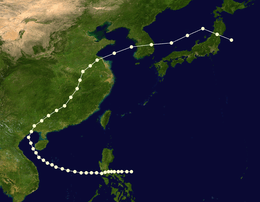1881 Haiphong typhoon
The 1881 Haiphong typhoon was a typhoon that struck Haiphong, in Dai Nam (now Vietnam), and the northern part of the Captaincy General of the Philippines (now the Philippines)[1] on October 8, 1881.[2] Formed east of Southern Luzon on September 27, 1881.
 Track of the 1881 Haiphong typhoon | |
| Formed | September 27, 1881 |
|---|---|
| Dissipated | October 8, 1881 |
| Lowest pressure | 957 hPa (mbar); 28.26 inHg |
| Fatalities | 300,000+ (Second-deadliest tropical cyclone on record) |
| Areas affected | Haiphong, Northern Vietnam Luzon, Captaincy General of the Philippines (now Philippines) |
| Part of the 1881 Pacific typhoon season | |
Gulf of Tonkin and Haiphong
The Gulf of Tonkin is a route sometimes taken by typhoons originating near the Philippines as they travel westward in the prevailing tropical easterlies.[3] In 1881 Haiphong Typhoon traveled this route after it originated near the Spanish East Indies.[3]
The city of Haiphong lies about 10 miles from the coast of the Gulf of Tonkin[2] and also on the Red River in a low elevation area (delta),[4] connected to an access channel. By the time the typhoon landed in 1881, the town was still a young port established by the French in 1874.[2]
Meteorological history
While the storm's category and strength is uncertain (like many disasters prior to the 20th century),[2] records show that the storm developed near the Philippines in late September and by the time it hit Luzon (Philippine island) on September 30, it was already strong enough to cause casualties and disrupt society. Once it was in the South China Sea, its power increased again as it entered into the Gulf of Tonkin, avoiding anymore land before it hit the gulf's coast.[4]
Casualties
| Rank | Name/Year | Region | Fatalities |
|---|---|---|---|
| 1 | Bhola 1970 | Bangladesh | 500,000 |
| 2 | India 1839 | India | 300,000 |
| Haiphong 1881 | Vietnam | 300,000 | |
| 4 | Nina 1975 | China | 229,000 |
| 5 | Bangladesh 1991 | Bangladesh | 138,866 |
| 6 | Nargis 2008 | Myanmar | 138,373 |
| Sources: NOAA, MDR | |||
In Vietnam alone, about 300,000 people were killed in and around Haiphong[5] (casualties likely went up even in the storm's passing due to disease and starvation[2]), and estimated 10,000–20,000 deaths in the modern territory of the Philippines, making it the deadliest Philippine typhoon ever recorded. It was three times the casualty count of Typhoon Haiyan (2013), the deadliest Philippine typhoon in modern meteorological records, and is the second-deadliest tropical cyclone in history of the world tied with India 1839 with over 300,000 fatalities..[3]
Haiphong, being a low-lying port town, was devastated both physically and economically. Its geography only made the damage escalate. With the high waves and winds, rice fields were flooded, buildings were decimated (and, as a result, people either were drowned or left stranded), trees were ripped up, etc. By the time the typhoon passed, most of the town was wiped out.[4] Then, due to the inability to operate as a port town, Haiphong's economy also took impact.[2]
Aftermath
The typhoon of 1881 is not a common occurrence because its path around Hainan is what made it so strong by the time it hit Haiphong. This has not happened again since 1881, but analyses predict that it will happen again. The Vietnamese government has also taken action in case of another severe typhoon hitting the area. Haiphong now has a flood defense system including dykes/levees (though not all of them are firm), a flood warning service provided by Vietnam's Meteorological Service, and evacuation plans. However, Haiphong still serves as a port (and a major one today), so any large storms will harm the economy.[4]
See also
References
- "Philippine Storm Surge History". Archived from the original on 2014-11-08. Retrieved 2013-12-24.
- "Haiphong cyclone | tropical cyclone". Encyclopædia Britannica. Retrieved 2016-09-14.
- HurricaneScience.org. Retrieved 2011-12-01.
- Terry, James P.; Winspear, Nigel; Cuong, Tran Quoc (2012-03-01). "The 'terrific Tongking typhoon' of October 1881 - implications for the Red River Delta (northern Vietnam) in modern times". Weather. 67 (3): 72–75. Bibcode:2012Wthr...67...72T. doi:10.1002/wea.882. ISSN 0043-1656.